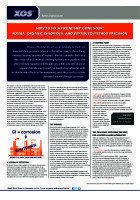Analytical Instrumentation
How to Fix a Friendship Gone Sour Russia Organic Chlorides and Improved Method Precision
Jan 28 2020
Author: Holly Dunn, Marketing Associate on behalf of XOS
Chlorine-contaminated crude oil poses dangers such as the creation of hydrochloric acid, which causes corrosion in refining equipment and pipelines. To avoid these pitfalls, refineries and terminals throughout the world have adopted ASTM D4929C and have implemented a test frequency of every four hours. ASTM D4929C uses XRF (X-ray Fluorescence) to measure the levels of chlorine content in crude, and is a fast, easy, and precise process compared to alternate methods like ICP.
Read our whitepaper to learn about a viable solution that allows refineries to obtain organic chloride concentrations in crude oil with increased precision and efficiency.
Digital Edition
PIN 25.2 Apr/May
May 2024
Safety - Carbon monoxide toxic and flammable gas detection Analytical Instrumentation - Density: A fundamental parameter at critical stages within the petroleum sector - Advancements and...
View all digital editions
Events
Jul 10 2024 Birmingham, UK
Thailand Oil & Gas Roadshow 2024
Jul 11 2024 Rayong, Thailand
Jul 20 2024 Denver, CO, USA
Jul 21 2024 Cape Town, South Africa
Jul 24 2024 Bogata, Colombia















